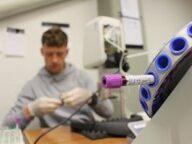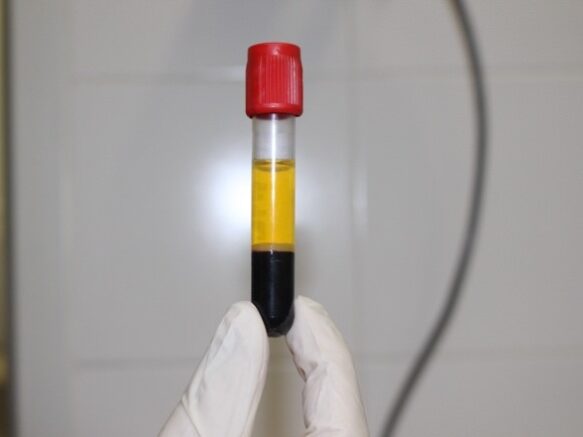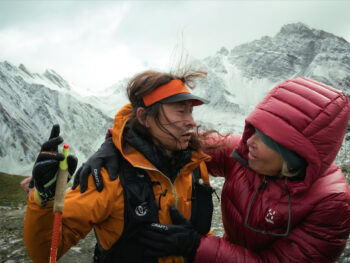Bastien Krumm with Guia Tagliapietra and the research group of Prof. Grégoire Millet, University of Lausanne, Switzerland.
The human body contains about 5 to 7 liters of blood. Composed of hundreds of thousands of red blood cells, the blood plays a major role in living organisms.
Indeed, this is how oxygen is transported from our lungs to the rest of our body and returns carbon dioxide to the lungs.
Considering that the greater the intensity of the effort, the greater the oxygen demand, the oxygen transport capacity is key for all endurance sports.
Consequently, it has been demonstrated that athletes have a significantly higher number of red blood cells than average (Heinicke et al., 2001), allowing for faster oxygen transport and thus better endurance performance.


The lifespan of a red blood cell is around 120 days before it is out of circulation by the spleen. However, as the cell ages, its membrane undergoes various changes inducing a loss of deformability, making it more fragile and likely to be eliminated more quickly in the case of unexpected disturbances. This phenomenon is called hemolysis. Among the various causes of hemolysis, running, especially over long distances, is one of them. Indeed, beyond its numerous beneficial effects, the shocks sustained when running can have a fatal effect on the most fragile red blood cells. Therefore, because of the prolonged duration of ultra-marathons, a significant reduction in the number of red blood cells after such an event has long been hypothesized. However, all the studies conducted to date have only reported a modest impact of running on the total number of red blood cells, even after the 166 km UTMB (Robach et al., 2014). But what about a distance and race duration twice as long as such as for the Tor des Géants?
Following more than 15 years of research into the impact of this legendary race on runners' physiology, Prof. Grégoire Millet and his team set out to explore this topic never before investigated over such long distances. Indeed, due to the extreme stress imposed by this ultra-marathon, many physiological parameters such as neuromuscular parameters have been shown to be markedly altered after the race (Saugy et al., 2013). To answer this new question, blood analysis instruments were this time brought to Courmayeur. Among these scientific devices, is a particular device that can quantify the number of red blood cells in the body. Hence, after measuring more than 20 runners the day before the race, these same subjects repeated the measurements immediately after their arrival, allowing us to identify whether or not race-induced hemolysis has a negative effect on red blood cell count.

Overall, no reduction in the number of red blood cells has been observed. In other words, oxygen transport capacity does not appear to be altered by 366 km of mountain ultra-marathon. Nevertheless, additional parameters suggest probable changes in red blood cell behavior… Indeed, blood viscosity was interestingly reduced after the race, despite normalization with plasma volume. In addition, several markers associated with an acceleration in the production of red blood cells, known as erythropoiesis, were significantly increased after the race.
An increased erythropoiesis is not surprising in this context and can be explained by several factors. Firstly, exposure to an average altitude of 2000 m for several days will have an accelerating impact on red blood cell production. Secondly, physical exercise is also known to stimulate this production. Finally, the inflammatory response usually observed following prolonged effort may also play a role in this physiological process. Therefore, as young red blood cells still exhibit optimal deformation capacity, this could explain the reduction in viscosity observed after the race.
Taken together, these results point in the same direction: the destruction of the most fragile red blood cells due to repeated ground contact seems to be counterbalanced by the production of new, more resistant red blood cells. Therefore, despite the extreme effort induced by the race, it seems that the total number of red blood cells remains unaffected after the Tor des Géants. These findings confirm recent observations over shorter distances and challenge a long-established theory. Nevertheless, these results need to be confirmed following an even longer race... such as the Tor des Glaciers.
References
Heinicke, K., Wolfarth, B., Winchenbach, P., Biermann, B., Schmid, A., Huber, G., Friedmann, B., & Schmidt, W. (2001). Blood Volume and Hemoglobin Mass in Elite Athletes of Different Disciplines. Int J Sports Med, 22(7), 504-512.
Robach, P., Boisson, R. C., Vincent, L., Lundby, C., Moutereau, S., Gergele, L., Michel, N., Duthil, E., Feasson, L., & Millet, G. Y. (2014). Hemolysis induced by an extreme mountain ultra-marathon is not associated with a decrease in total red blood cell volume. Scand J Med Sci Sports, 24(1), 18-27.
Saugy, J., Place, N., Millet, G. Y., Degache, F., Schena, F., & Millet, G. P. (2013). Alterations of Neuromuscular Function after the World's Most Challenging Mountain Ultra-Marathon. PLoS One, 8(6), e65596.
© 2009-2024 by VDA Trailers SSDrl
Any dissemination for commercial purposes of photographic or video images captured during the event, via any means (internet, social networks, TV, press, magazines, etc.), without written authorisation from the organisation is prohibited. GTC®, GTC100™, GTC55™, GTC30™, TORX®, TOR®, Tor des Géants®, Tor des Glaciers™, Passage au Malatrà™, Tot Dret™, TOR450™, TOR330™, TOR130™, TOR100™ and TOR30™ are trademarks owned or used exclusively by VDA Trailers. Any communication of the event or use of images of it must be done in observance of the name of the event and registered trademarks, subject to agreement by the organisation.
Valle d’Aosta Trailers SSDrl | Via Roma, 98 | 11013 Courmayeur | CF/P.IVA 01139360075 | Nr. Iscr. Reg. Imprese AOSTA AO-70629




